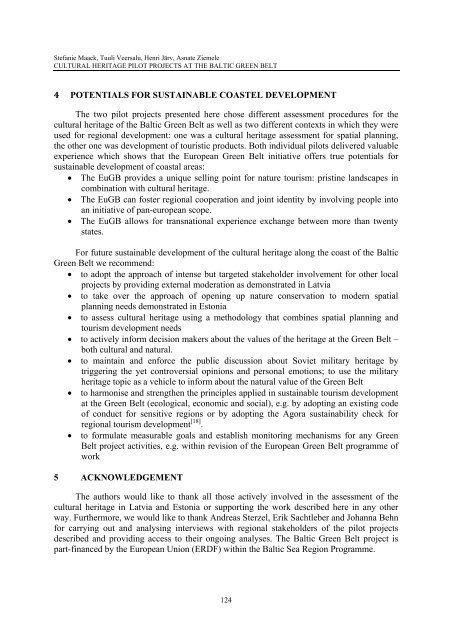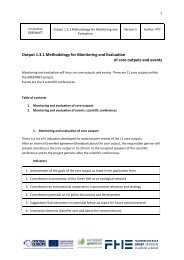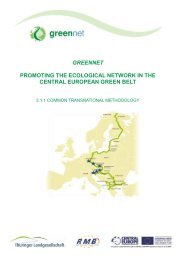The Green Belt as a European Ecological Network strengths and gaps
The Green Belt as a European Ecological Network strengths and gaps
The Green Belt as a European Ecological Network strengths and gaps
You also want an ePaper? Increase the reach of your titles
YUMPU automatically turns print PDFs into web optimized ePapers that Google loves.
Stefanie Maack, Tuuli Veersalu, Henri Järv, Asnate Ziemele<br />
CULTURAL HERITAGE PILOT PROJECTS AT THE BALTIC GREEN BELT<br />
4 POTENTIALS FOR SUSTAINABLE COASTEL DEVELOPMENT<br />
<strong>The</strong> two pilot projects presented here chose different <strong>as</strong>sessment procedures for the<br />
cultural heritage of the Baltic <strong>Green</strong> <strong>Belt</strong> <strong>as</strong> well <strong>as</strong> two different contexts in which they were<br />
used for regional development: one w<strong>as</strong> a cultural heritage <strong>as</strong>sessment for spatial planning,<br />
the other one w<strong>as</strong> development of touristic products. Both individual pilots delivered valuable<br />
experience which shows that the <strong>European</strong> <strong>Green</strong> <strong>Belt</strong> initiative offers true potentials for<br />
sustainable development of co<strong>as</strong>tal are<strong>as</strong>:<br />
<strong>The</strong> EuGB provides a unique selling point for nature tourism: pristine l<strong>and</strong>scapes in<br />
combination with cultural heritage.<br />
<strong>The</strong> EuGB can foster regional cooperation <strong>and</strong> joint identity by involving people into<br />
an initiative of pan-european scope.<br />
<strong>The</strong> EuGB allows for transnational experience exchange between more than twenty<br />
states.<br />
For future sustainable development of the cultural heritage along the co<strong>as</strong>t of the Baltic<br />
<strong>Green</strong> <strong>Belt</strong> we recommend:<br />
to adopt the approach of intense but targeted stakeholder involvement for other local<br />
projects by providing external moderation <strong>as</strong> demonstrated in Latvia<br />
to take over the approach of opening up nature conservation to modern spatial<br />
planning needs demonstrated in Estonia<br />
to <strong>as</strong>sess cultural heritage using a methodology that combines spatial planning <strong>and</strong><br />
tourism development needs<br />
to actively inform decision makers about the values of the heritage at the <strong>Green</strong> <strong>Belt</strong> –<br />
both cultural <strong>and</strong> natural.<br />
to maintain <strong>and</strong> enforce the public discussion about Soviet military heritage by<br />
triggering the yet controversial opinions <strong>and</strong> personal emotions; to use the military<br />
heritage topic <strong>as</strong> a vehicle to inform about the natural value of the <strong>Green</strong> <strong>Belt</strong><br />
to harmonise <strong>and</strong> strengthen the principles applied in sustainable tourism development<br />
at the <strong>Green</strong> <strong>Belt</strong> (ecological, economic <strong>and</strong> social), e.g. by adopting an existing code<br />
of conduct for sensitive regions or by adopting the Agora sustainability check for<br />
regional tourism development [18] .<br />
to formulate me<strong>as</strong>urable goals <strong>and</strong> establish monitoring mechanisms for any <strong>Green</strong><br />
<strong>Belt</strong> project activities, e.g. within revision of the <strong>European</strong> <strong>Green</strong> <strong>Belt</strong> programme of<br />
work<br />
5 ACKNOWLEDGEMENT<br />
<strong>The</strong> authors would like to thank all those actively involved in the <strong>as</strong>sessment of the<br />
cultural heritage in Latvia <strong>and</strong> Estonia or supporting the work described here in any other<br />
way. Furthermore, we would like to thank Andre<strong>as</strong> Sterzel, Erik Sachtleber <strong>and</strong> Johanna Behn<br />
for carrying out <strong>and</strong> analysing interviews with regional stakeholders of the pilot projects<br />
described <strong>and</strong> providing access to their ongoing analyses. <strong>The</strong> Baltic <strong>Green</strong> <strong>Belt</strong> project is<br />
part-financed by the <strong>European</strong> Union (ERDF) within the Baltic Sea Region Programme.<br />
124




